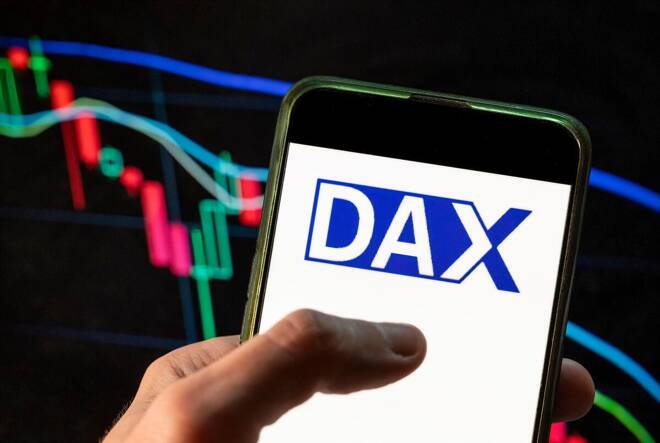Advertisement
Advertisement
Dax Index News: Forecast Bearish as Trump Faces China and EU Retaliation
By:
Key Points:
- On April 4, DAX plunged 4.95% on China’s 34% tariffs, signaling deepening fears of a full-scale trade war.
- Experts warn of a surge in Chinese exports to the EU at dumping prices, threatening German industry.
- DAX outlook hinges on trade war updates, US inflation data, and central bank guidance this week.
DAX Plunges on China Tariff Retaliation
German stocks plunged on Friday, April 4, with the DAX posting its steepest weekly drop (-8.1%) since February 2022. Markets reacted to China’s retaliatory measures against Trump’s 34% tariff hike on Chinese goods, intensifying fears of a full-scale global trade war.
The DAX dropped 4.95% after sliding 3.01% on April 3, closing at 20,642, its lowest since January 15.
On April 4, China announced several countermeasures targeting US goods and firms, including:
- Canceling a deal to sell TikTok to the US.
- Imposing 34% tariffs on US goods, effective April 10.
- Export controls on select rare earth items.
- Suspension of import licenses for six US companies’ products.
Fears that low-priced Chinese goods could flood the EU market added to tensions.
Daniel Kral, Europe macro specialist at Oxford Economics, commented:
“Value of Chinese goods exports to the US and the EU is similar ($450-500 billion). Apart from some (iPhones for the US, cars & machinery for the EU), the product split is very similar. With many Chinese products shut out of the US due to prohibitive tariffs, the EU should indeed brace for a flood at dumping prices.”
Kral also noted that China competes with the EU in the export markets across more products than ever before, stating:
“The steepest rise in competition has been with Italy and Germany, whose industry sectors have been the worst performers in Europe.”
German Factory Orders Disappoint
German factory orders stalled in February after tumbling 7% month-on-month (MoM) in January. Economists had expected a 3.5% (MoM) rebound. February’s orders signaled waning demand for German goods despite global buyers front-loading orders ahead of US tariffs.
Friday’s data added to the gloomy mood, with a global trade war likely to further impact demand for German goods.
Banks Lead Losses Amid Recession Fears
Escalating trade tensions and mounting recession fears sent bank stocks reeling. Deutsche Bank led the Friday sell-off, plunging 9.77%, while Commerzbank slid 5.38%.
Losses spread across key sectors:
Auto sector: Mercedes-Benz Group dropped 5.21%.
Pharma sector: Fresenius Medical Care fell 4.59%.
Retail sector: Zalando slid 6.51%.
Tech sector: Infineon Technologies tumbled 7.08%.
German Industrial Production and Trade in Focus
German industrial production and trade data on Monday, April 7, could provide a distraction from the escalating global trade war. While upbeat data could briefly lift sentiment, markets may interpret strength as a pre-tariff anomaly, dampening its impact. On the other hand, weaker-than-expected figures may deepen concerns about the German economy, potentially weighing on German-listed stocks.
US Markets Rattled by Trade Tensions
US equity markets suffered a second session of heavy losses on Friday, April 4. The Nasdaq Composite Index slumped 5.82%, while the Dow and the S&P 500 dropped 5.50% and 5.97%, respectively.
In the bond markets, safe-haven demand pushed 10-year US Treasury yields to a session low of 3.86% before recovering to 4%.
An upbeat US Jobs Report offered brief relief from the Friday market sell-off. Nonfarm payrolls jumped by 228k in March, up from 117k in February, while average hourly earnings eased, suggesting potentially softer inflation.
Outlook: Trade Negotiations and the Fed in Focus
In Monday’s US session, trade-related headlines and Fed forward guidance will be crucial for risk assets.
- Bullish Scenario: Early progress in trade negotiations and Fed support for rate cuts to bolster the US economy could boost demand for German stocks.
- Bearish Scenario: An escalation in the trade war or Fed caution against cutting rates may drive the DAX lower.
Near-Term Outlook: Key Drivers
The DAX remains highly sensitive to three key themes: US inflation trends, tariff updates, and central bank commentary.
Potential DAX Scenarios:
- Bullish Case: Easing trade tensions, softer US inflation (April 10), or dovish central bank forward guidance may drive the DAX toward 22,000.
- Bearish Case: An escalation in trade tensions, hotter US inflation, or more hawkish central bank stances could drag the DAX below the 200-day EMA and toward 20,000.
As of Monday morning, the DAX futures were down 699 points, while the Nasdaq 100 mini fell 549 points, signaling a challenging start to the week.
DAX Technical Indicators
Daily Chart:
After last week’s sell-off, the DAX remains below the 50-day Exponential Moving Average (EMA) while holding above the 200-day EMA. The EMAs signal short-term downside risks.
- Upside Target: A breakout above 21,000 would support a move toward 21,500. A return to 21,500 could enable the bulls to target the 50-day EMA.
- Downside risk: A drop below the 200-day EMA would open the door to a fall below 20,000. A decisive drop below 20,000 may open the path to the 19,675 support level.
With the RSI at 29.36, the DAX is in oversold territory (below 30). Buying pressure could intensify at Friday’s low of 20,437.
Conclusion: Track Key Macroeconomic Drivers
Investors should watch for tariff announcements, central bank guidance, and US inflation data. These key drivers will influence the DAX’s price trajectory in the coming sessions.
Explore our latest research here for deeper insights into the DAX, global macro trends, and emerging market opportunities.
About the Author
Bob Masonauthor
With over 28 years of experience in the financial industry, Bob has worked with various global rating agencies and multinational banks. Currently he is covering currencies, commodities, alternative asset classes and global equities, focusing mostly on European and Asian markets.
Did you find this article useful?
Latest news and analysis
Advertisement
